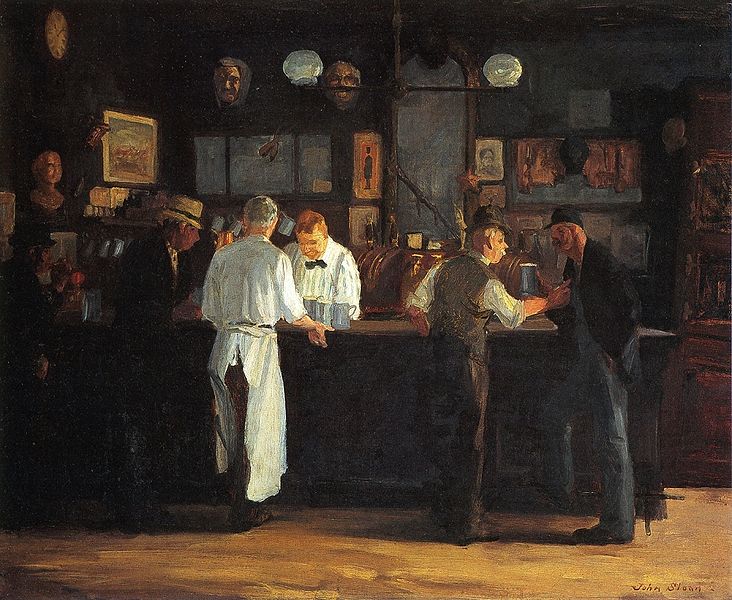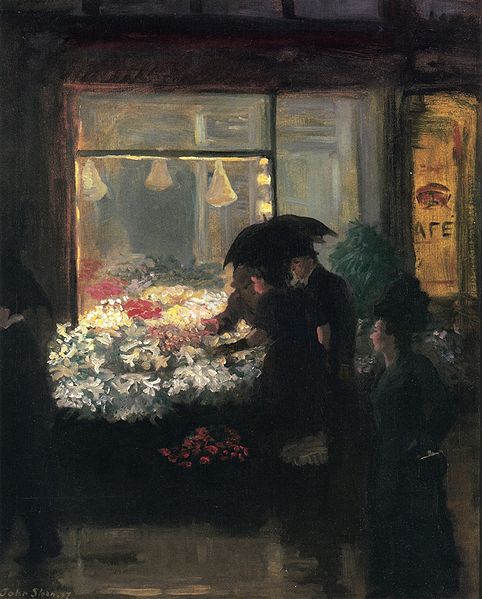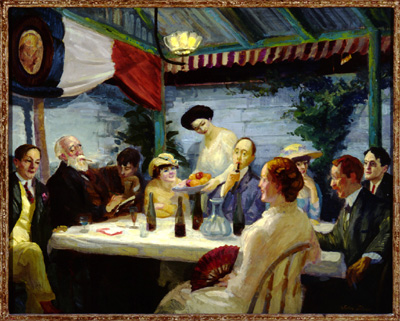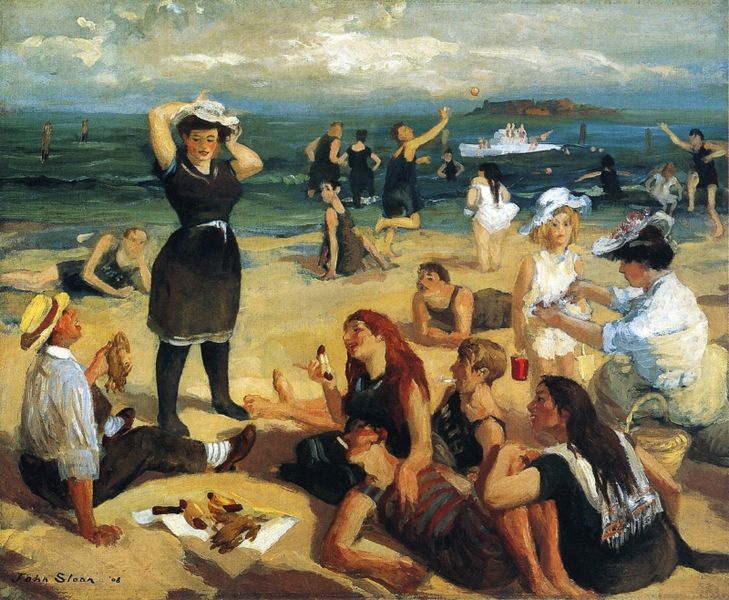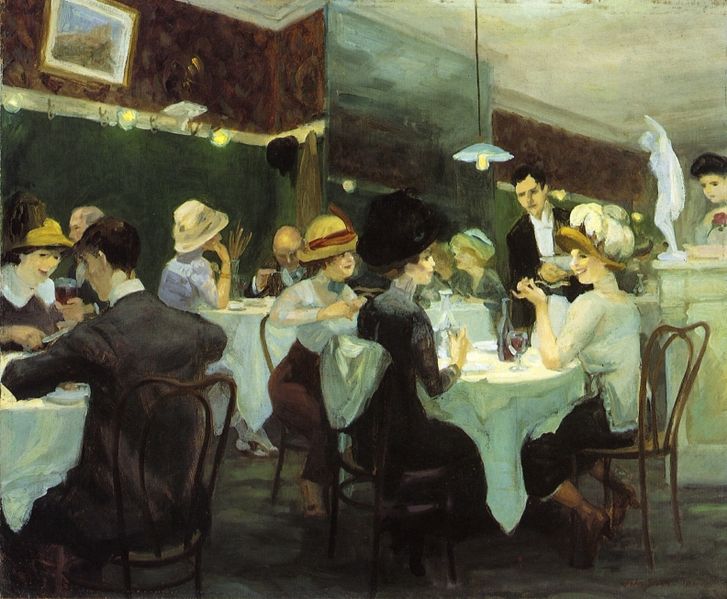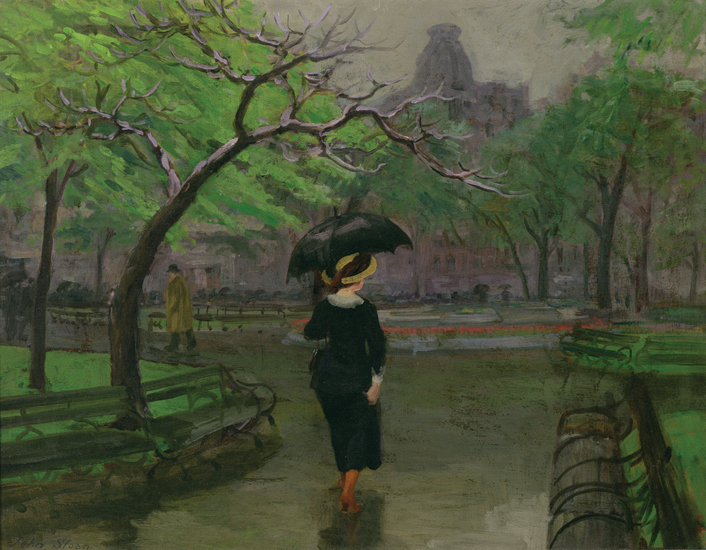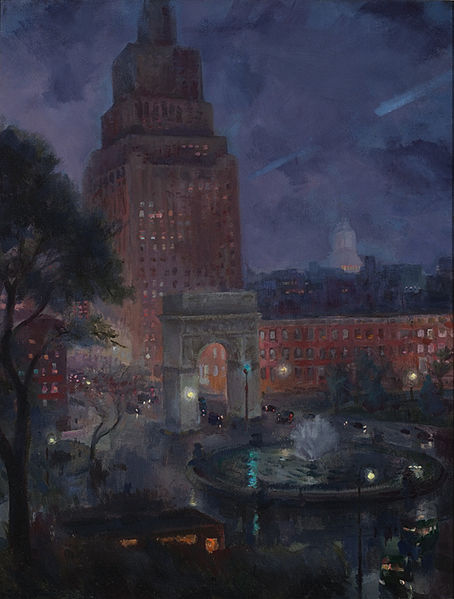<Back to Index>
- Painter John French Sloan, 1871
PAGE SPONSOR
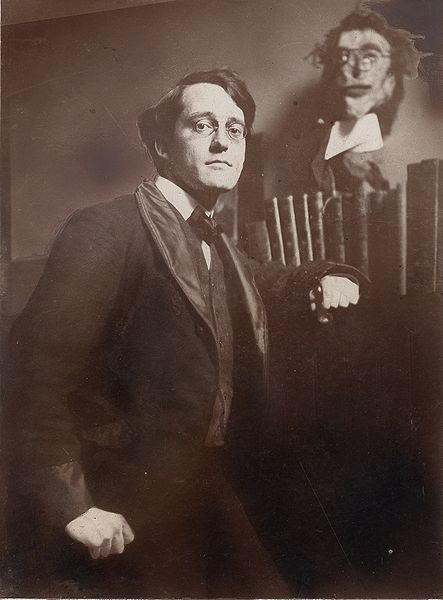
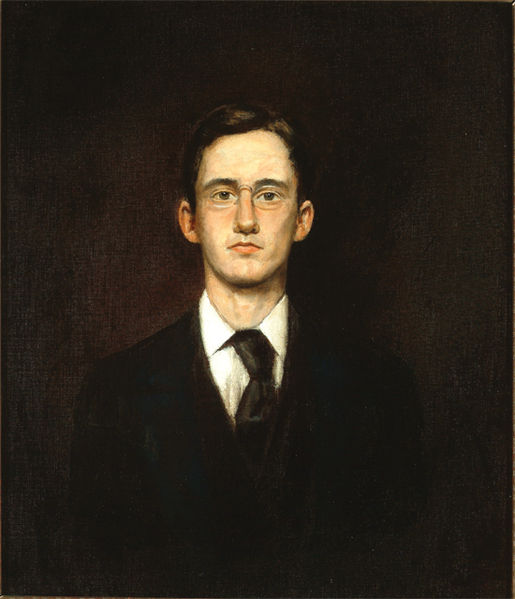
John French Sloan (August 2, 1871 – September 7, 1951) was an American artist. As a member of The Eight, he became a leading figure in the Ashcan School of realist artists. He was known for his urban genre painting and ability to capture the essence of neighborhood life in New York City, often through his window. Sloan has been called "the premier artist of the Ashcan School who painted the inexhaustible energy and life of New York City during the first decades of the twentieth century", and an "early twentieth - century realist painter who embraced the principles of socialism and placed his artistic talents at the service of those beliefs."
John Sloan was born in Lock Haven, Pennsylvania, on August 2, 1871, to James Dixon, a man with artistic leanings who made an unsteady income in a succession of jobs, and Henrietta Sloan, a schoolteacher from an affluent family. Sloan grew up in Philadelphia, Pennsylvania, where he lived and worked until 1904, when he moved to New York City. He and his two sisters were encouraged to draw and paint from an early age. In the fall of 1884 he started high school at Central High School in Philadelphia, where his classmates included William Glackens and Albert C. Barnes.
In the spring of 1888, his father experienced a mental breakdown that left him unable to work, and Sloan became responsible, at the age of 16, for the support of his parents and sisters. He dropped out of school in order to work full time as an assistant cashier at Porter and Coates, a bookstore and seller of fine prints. His duties were light, allowing him many hours to read the books and examine the works in the store's print department. It was there that Sloan created his earliest surviving works, among which are pen and ink copies after Dürer and Rembrandt. He also began making etchings, which were sold in the store for a modest sum. In 1890, the offer of a higher salary persuaded Sloan to leave his position to work for A. Edward Newton, a former clerk for Porter and Coates who had opened his own stationery store. At Newton's, Sloan designed greeting cards and calendars, and continued with his etchings. In that same year he also attended a night drawing class at the Spring Garden Institute, which provided him his first formal art training.
He soon left Newton's business in quest of greater freedom as a freelance commercial artist, but this venture produced little income. In 1892, he began working as an illustrator in the art department of The Philadelphia Inquirer. Later that same year, Sloan began taking evening classes at the Pennsylvania Academy of the Fine Arts under the guidance of Thomas Pollock Anshutz. Among his fellow students was his old schoolmate William Glackens.
At a Christmas party in 1892, Sloan met Robert Henri, a charismatic advocate of artistic independence who became a mentor to him. Henri encouraged Sloan and eventually convinced him to turn to painting. They were lifelong friends, shared a common artistic outlook, and together promoted a new form of realism that helped to redefine American Art. In 1893, Sloan and Henri founded the Charcoal Club together, which would also include Glackens, George Luks and Everett Shinn.
Towards the end of 1895, Sloan decided to leave The Philadelphia Inquirer to work in the art department of The Philadelphia Press. His schedule was now less rigid, allowing him more time to paint. Henri offered encouragement, and often sent Sloan reproductions of European artists, such as Manet, Hals, Goya and Velázquez.
In 1898, the socially awkward Sloan was introduced to Anna Maria (Dolly) Wall (born July 28, 1876), and the two fell immediately in love. In entering into a relationship with her, Sloan accepted the challenges posed by her alcoholism and her sexual history, which included prostitution; although Dolly worked in a department store by day, Sloan met her in a brothel. The two were married on August 5, 1901, providing Sloan with an affectionate partner who believed in him absolutely, but whose lapses and mental instability led to frequent crises.
By 1903 he had produced about sixty oil paintings in total. In April 1904, Sloan moved to New York City, and soon found quarters in Greenwich Village where he painted some of his best known works, including McSorley's Bar, Sixth Avenue Elevated at Third Street, and Wake of the Ferry. His time in New York was his most prolific period, but he sold little, and he continued to rely on his earnings as a freelancer for The Philadelphia Press, for which he continued to draw weekly puzzles until 1910. By 1905 he was supplementing this income by drawing illustrations for books (including The Moonstone) and for such journals as Collier's Weekly, Good Housekeeping, Harper's Weekly, The Saturday Evening Post and Scribner's. Sloan participated in the 1908 exhibition at the Macbeth Galleries of a group that included the five artists from the Philadelphia Charcoal Club as well as Maurice Prendergast, Ernest Lawson and Arthur B. Davies, who were afterward collectively known as "The Eight".
A doctor who was consulted in an effort to help Dolly overcome her drinking problem suggested a scheme to Sloan: he was to start a diary in which he would include his fondest thoughts of her, with the expectation that she would surreptitiously read it and be freed of her disabling fear that Sloan would leave her. Spanning the period from 1906 to early 1913, the diary soon grew beyond its initial purpose, and its publication in 1965 supplied researchers with a detailed chronicle of Sloan's activities and interests.
Sloan's growing discontent with what he called "the Plutocracy's government" led him to join the Socialist party in 1910. He became the art editor of The Masses with the December 1912 issue, and contributed drawings to other socialist publications such as the Call and Coming Nation. As Sloan disliked propaganda, his work for these magazines often lacked overt political content. This was unacceptable to a faction of his fellow editors at The Masses, causing him to resign his position with the journal in 1916. He later became disenchanted with the Communist Party in America, although he remained hopeful that the Soviet Union would succeed in creating an egalitarian society.
In 1913, Sloan painted a huge backdrop for the Paterson Strike Pageant. The play, a benefit performance for the striking silk mill workers, took place in Madison Square Garden, and incorporated over 1,000 actors.
In February 1913, Sloan participated in the Armory Show. He served as a member of the committee that organized it, and also exhibited two paintings and five etchings. In that same year, the important collector Albert C. Barnes purchased one of Sloan's paintings; this was only the fourth sale of a painting for Sloan (although it has often erroneously been counted as his first). For Sloan, exposure to the European modernist works on view in the Armory Show initiated a gradual move away from the urban themes he had been painting for the previous ten years. In 1914 – 15, during summers spent in Gloucester, Massachusetts, he painted landscapes outdoors in a new, more colorful style influenced by Van Gogh and the Fauves.
Beginning in 1914, Sloan taught at the Art Students League, continuing for about ten years. Sloan also taught briefly at the George Luks Art School. His students respected him for his practical knowledge and integrity, but feared his caustic tongue; as a well known painter who had nonetheless sold very few paintings, he advised his students, "I have nothing to teach you that will help you to make a living".
The summer of 1918 was the last he spent in Gloucester. For the next 30 years, he spent four months each summer in Santa Fe, New Mexico, where the desert landscape inspired a new concentration on the rendering of form. Still, the majority of his works were completed in New York. He developed a strong interest in Native American arts and ceremonies, and became an advocate of Indian artists. He also championed the work of Diego Rivera, who he called "the one artist on this continent who is in the class of the old masters." The Society of Independent Artists, which Sloan had co-founded in 1916, gave Rivera and José Clemente Orozco their first showing in the United States in 1920.
In 1943, his wife, Dolly, died of coronary heart disease. The next year, Sloan married Helen Farr, who is responsible for most of the preservation of his works. On September 7, 1951 John Sloan died of cancer in Hanover, New Hampshire.
John Sloan's training consisted of his study and reproduction of works by painters such as Rembrandt, a few classes at various institutions, mentorship by Robert Henri, and his work experience as an etcher and draughtsman. It is recorded that the high school that Sloan attended had a good art department, but it is not known whether he gained any training there. Sloan worked several jobs in draughtsmanship, etching and making commercial artwork before he attended The Pennsylvania Academy of the Fine Arts, where he studied under Thomas Pollock Anshutz. The experience Sloan gathered from his various press jobs provided him with a certain amount of knowledge and allowed room for him to explore and expand in his free time. Henri's mentorship was significant in Sloan's training because he encouraged him to paint more, and introduced him to the work of various artists, whose techniques, composition, and style Sloan studied. He sought additional guidance from Ruskin's The Elements of Drawing and John Collier's A Manual of Oil Painting. Sloan believed his study and mentorship at The Pennsylvania Academy of the Fine Arts, as well as his early Philadelphia experiences, to be his "college education."
At a young age Sloan had been exposed to numerous books and reproductions through his uncle, Alexander Priestley, who held an extensive collection in his library. One major influence that he discovered was John Leech, an English caricaturist. When Sloan entered his position at The Philadelphia Press his newspaper drawings reflected the style of Leech, Charles Keene and George du Maurier. But in 1894 he had begun attracting attention with decorative illustrations in a new style related to the poster movement; these works combine the influences of European artists of the late 19th and early 20th century, including Walter Crane, and reveal Sloan's study of Botticelli and Japanese prints.
Sloan's early paintings may have been influenced by Thomas Eakins as a result of his time studying under Anshutz at The Pennsylvania Academy of the Fine Arts. In 1893, Sloan and Glackens became regulars at a weekly "open house" at Henri's studio, where he led discussions of such books as George Moore's Modern Painting and William Morris Hunt's Talks on Art. "Both Eakins and Moore emphasized the importance of life in art, one of the ideas Henri is credited with having passed on to the young newspaper artists."
He was a member of The Eight, a group of realist artists that included Robert Henri, Everett Shinn, Arthur B. Davies, Ernest Lawson, Maurice Prendergast, George Luks and William Glackens. The Eight are closely identified with the Ashcan School, although Sloan despised this term. Unlike Henri, Sloan was not a facile painter, and labored over his work — leading Henri to remark that "Sloan" was "the past participle of 'slow'". When Glackens and Sloan were at The Philadelphia Inquirer, Glackens usually got the reportorial assignments because he was more adept than Sloan in making quick sketches. His slow and methodical approach towards sketching carried over to his painting. "Sloan's approach to making urban realist art was based on images seen and remembered (and sometimes written down) rather than sketched in the street, even though his autographic handling of paint and print media conveys the look of a rapid drawing. The effect is conceptual rather than perceptual, which Sloan denigrated as "eyesight" painting." This was a major characteristic of his style, consistent with the Ashcan School's goal of presenting a subject to the viewer with all the immediacy of a snapshot.
Sloan tended to observe city life and dwellers interacting in an intimate setting as they interact. He "concerned himself with what we call genre: street scenes, restaurant life, paintings of saloons, ferry boats, roof tops, back yards, and so on through a whole catalogue of commonplace subjects." Like Edward Hopper, Sloan often used the perspective of the window in his painting, in order to focus closely, but also in order to observe the subject undetected. He wrote in his diary, in 1911 ; "I am in the habit of watching every bit of human life I can see about my windows, but I do it so that I am not observed at it ... No insult to the people you are watching to do so unseen." Sloan's attention to isolated incidents within the urban environment recalls the narrative techniques used in the realist fiction and Hollywood films he enjoyed.
Whenever Sloan was asked about the social context of his paintings or about his association with Socialism, he said that they were done with "sympathy, but no social consciousness." "I was never interested in putting propaganda into my paintings, so it annoys me when art historians try to interpret my city life pictures as 'socially conscious.' I saw the everyday life of the people, and on the whole I picked out bits of joy in human life for my subject matter." In the late 1920s, Sloan changed his technique, and abandoned his characteristic urban subject matter in favor of nudes and portraits. Rejecting as superficial the spontaneous, painterly technique of such artists as Manet and Hals — and also of Henri and his followers among The Eight — he turned instead to the underpainting and glazing method used by old masters such as Andrea Mantegna. The resulting paintings, which often made unconventional use of superimposed hatchings to define the forms, have never attained the popularity of his early Ashcan works.
Among John Sloan's best known paintings are Hairdresser's Window (1907), in the Wadsworth Atheneum, The Picnic Ground (1907), in the Whitney Museum of American Art, The Haymarket (1907), in The Brooklyn Museum, and McSorley's Bar (1912). In 1971, his painting Wake of the Ferry (1907, in The Phillips Collection, Washington, D.C.) was reproduced on a U.S. postage stamp honoring Sloan.
His students included Alexander Calder, Reginald Marsh, Peggy Bacon, Aaron Bohrod, Barnett Newman and Norman Raeben. In 1939 he published a book of his teachings, Gist of Art.
In American Visions the critic Robert Hughes praised the influence of "the most lyrical, and politically acerbic of the Ashcan artists, 'a spectator of life', as he called himself. Sloan's work had an honest humane-ness, a frank sympathy, he refused to flatten lower - class New Yorkers into stereotypes of misery, and his strong sense of the moments in which ordinary people are seen unawares, or isolated, was to deeply affect the leading artist of the next generation, Edward Hopper."
The lobby of the United States Post Office in Bronxville, New York, features a mural by Sloan painted in 1939 and titled The Arrival of the First Mail in Bronxville in 1846. The post office and mural were listed on the National Register of Historic Places in 1988.
